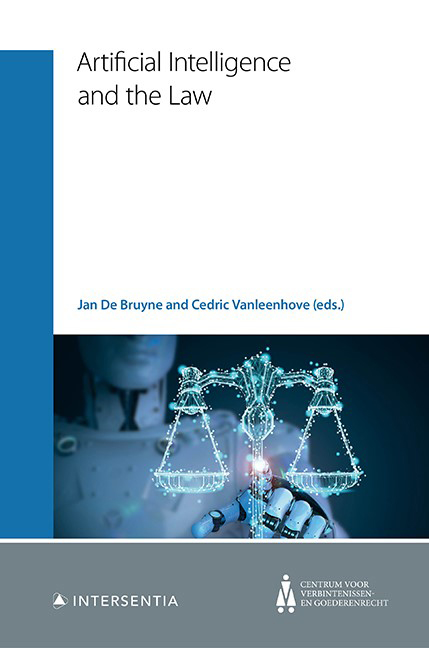Book contents
- Frontmatter
- Contents
- Foreword
- Contributing Authors
- Chapter 1 Basic Concepts of AI for Legal Scholars
- Chapter 2 Different Models of Innovation and Their Relation to Law
- Chapter 3 Setting the Scene: On AI Ethics and Regulation
- Chapter 4 Quantitative Legal Prediction: the Future of Dispute Resolution?
- Chapter 5 AI Arbitrators … ‘Does Not Compute’
- Chapter 6 AI through a Human Rights Lens. The Role of Human Rights in Fulfilling AI’s Potential
- Chapter 7 Killer Robots: Lethal Autonomous Weapons and International Law
- Chapter 8 AI and Data Protection: the Case of Smart Home Assistants
- Chapter 9 AI and IP: a Tale of Two Acronyms
- Chapter 10 Tax and Robots
- Chapter 11 Robotisation and Labour Law. The Dark Factory: the Dark Side of Work?
- Chapter 12 The Hypothesis of Technological Unemployment Caused by AI-Driven Automation and its Impact on Social Security Law
- Chapter 13 AI in Belgian Contract Law: Disruptive Challenge or Business as Usual?
- Chapter 14 Tort Law and Damage Caused by AI Systems
- Chapter 15 Insurance Underwriting on the Basis of Telematics: Segmentation and Profiling
- Chapter 16 AI and Creditworthiness Assessments: the Tale of Credit Scoring and Consumer Protection. A Story with a Happy Ending?
- Chapter 17 AI and the Consumer
- Chapter 18 Robots and AI in the Healthcare Sector: Potential Existing Legal Safeguards Against a(n) (Un)justified Fear for ‘Dehumanisation’ of the Physician-Patient Relationship
Chapter 15 - Insurance Underwriting on the Basis of Telematics: Segmentation and Profiling
Published online by Cambridge University Press: 26 May 2021
- Frontmatter
- Contents
- Foreword
- Contributing Authors
- Chapter 1 Basic Concepts of AI for Legal Scholars
- Chapter 2 Different Models of Innovation and Their Relation to Law
- Chapter 3 Setting the Scene: On AI Ethics and Regulation
- Chapter 4 Quantitative Legal Prediction: the Future of Dispute Resolution?
- Chapter 5 AI Arbitrators … ‘Does Not Compute’
- Chapter 6 AI through a Human Rights Lens. The Role of Human Rights in Fulfilling AI’s Potential
- Chapter 7 Killer Robots: Lethal Autonomous Weapons and International Law
- Chapter 8 AI and Data Protection: the Case of Smart Home Assistants
- Chapter 9 AI and IP: a Tale of Two Acronyms
- Chapter 10 Tax and Robots
- Chapter 11 Robotisation and Labour Law. The Dark Factory: the Dark Side of Work?
- Chapter 12 The Hypothesis of Technological Unemployment Caused by AI-Driven Automation and its Impact on Social Security Law
- Chapter 13 AI in Belgian Contract Law: Disruptive Challenge or Business as Usual?
- Chapter 14 Tort Law and Damage Caused by AI Systems
- Chapter 15 Insurance Underwriting on the Basis of Telematics: Segmentation and Profiling
- Chapter 16 AI and Creditworthiness Assessments: the Tale of Credit Scoring and Consumer Protection. A Story with a Happy Ending?
- Chapter 17 AI and the Consumer
- Chapter 18 Robots and AI in the Healthcare Sector: Potential Existing Legal Safeguards Against a(n) (Un)justified Fear for ‘Dehumanisation’ of the Physician-Patient Relationship
Summary
INTRODUCTION
1. AI and IoT have been rolled out with spectacular speed in an increasing number of areas. It is transforming the way in which society and the economy operate. As a late adopter, the insurance industry is also starting to embrace the digital transformation. Insurance companies are exchanging traditional business models for new paradigms such as ‘Connected Insurance’, ‘Usagebased Insurance’ (‘UBI’), and ‘Smart Underwriting’. In the same vein, consumers of insurance products and services are seeking on-demand, personalised experiences. The types of risks being covered are also evolving, presenting fresh business opportunities for insurers to reimagine their business by building a digital-enabled core to deliver sustainable operational efficiencies. The insurance industry is adopting a wide variety of digital technologies to meet these ever-changing demands. These technologies will help insurers to reduce costs, optimise business processes, launch new innovative product offerings and improve customer experience. For all its potential benefits, it bears no doubt that this digital transformation gives rise to legal challenges.
2. This chapter will elaborate on one specific technological development within the insurance sector, namely the use of telematics in policy underwriting. Underwriting involves measuring risk exposure and determining the premium that needs to be charged to insure that risk. The main technological development which will be the subject of this chapter is UBI. In the context of this chapter, UBI is a type of motor vehicle liability insurance (further referred to as ‘vehicle insurance’) that tracks driving habits and driving behaviour. Basically, UBI means that a driver's behaviour and habits are monitored directly while the person drives, allowing insurers to more closely align driving behaviour and habits with premium rates. Oftentimes, UBI is powered by in-vehicle telecommunication devices (also referred to as ‘telematics’) which are either integrated by the vehicle manufacturers, self-installed using a plug-in device or available through mobile applications.
3. This chapter will introduce policy underwriting in Belgian insurance in general terms, with a specific focus on the underwriting process in vehicle insurance (part 2). Afterwards, the concept of UBI will be elaborated upon (part 3).
- Type
- Chapter
- Information
- Artificial Intelligence and the Law , pp. 405 - 428Publisher: IntersentiaPrint publication year: 2021
- 1
- Cited by



